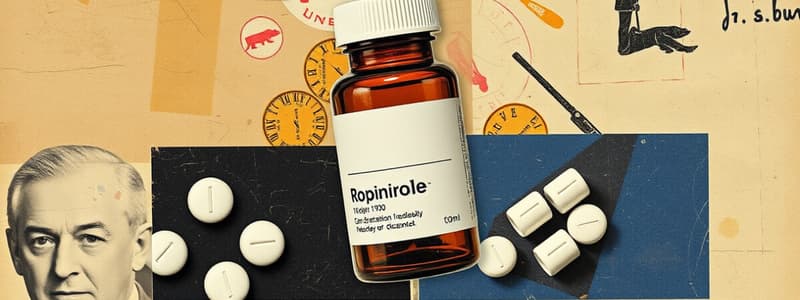Podcast
Questions and Answers
What is the generic name of Ropinirole?
What is the generic name of Ropinirole?
- Requip (correct)
- Dopamine
- Ropinirole
- Antidyskinetic
What is the classification of Ropinirole?
What is the classification of Ropinirole?
Antidyskinetic
What is the mechanism of action of Ropinirole?
What is the mechanism of action of Ropinirole?
Directly stimulates postsynaptic dopamine type 2 receptors within the brain and acts as an agonist at peripheral D2 receptors, inhibits the firing of cholinergic neurons.
Common side effects of Ropinirole include ______, dizziness, and fatigue.
Common side effects of Ropinirole include ______, dizziness, and fatigue.
Why is Ropinirole prescribed?
Why is Ropinirole prescribed?
What nursing implications should be considered when administering Ropinirole?
What nursing implications should be considered when administering Ropinirole?
Flashcards are hidden until you start studying
Study Notes
Ropinirole Overview
- Ropinirole is a medication primarily known by its generic name, Requip.
- Classified as an antidyskinetic, it is used to manage motor symptoms related to Parkinson's disease.
Mechanism of Action
- Acts by directly stimulating postsynaptic dopamine type 2 receptors in the brain.
- Functions as an agonist at peripheral D2 receptors, influencing various neurological pathways.
- Inhibits the firing of cholinergic neurons, contributing to its therapeutic effects.
Side Effects
- Common side effects include headaches, dizziness, and asthenia (weakness).
- Patients may experience fatigue, paresthesia (tingling sensations), and tremors.
- More serious effects may involve chest pain, hypertensive crises, and arrhythmias.
- Other potential side effects include nausea and vomiting, diarrhea, dry mouth, elevated BUN (Blood Urea Nitrogen) levels, urinary tract infections (UTIs), dyspnea (difficulty breathing), and diaphoresis (excessive sweating).
Usage
- Prescribed to alleviate the signs and symptoms associated with Parkinson's disease, helping to improve motor functions.
Nursing Considerations
- Nurses should monitor for signs of excessive sedation and acute drowsiness, which may manifest even a year after initiating therapy.
- It's essential to assess for altered mental status, especially during drug withdrawal, as this may indicate complications or side effects.
Studying That Suits You
Use AI to generate personalized quizzes and flashcards to suit your learning preferences.

